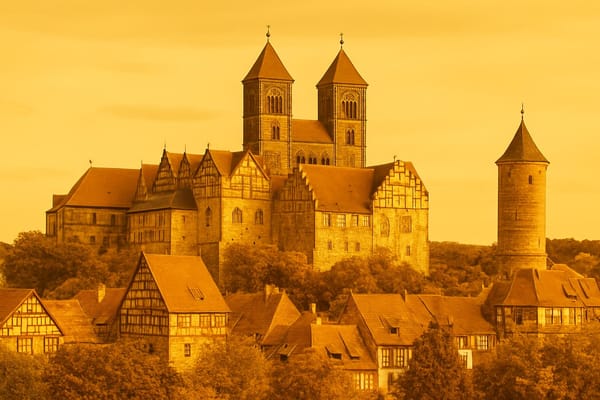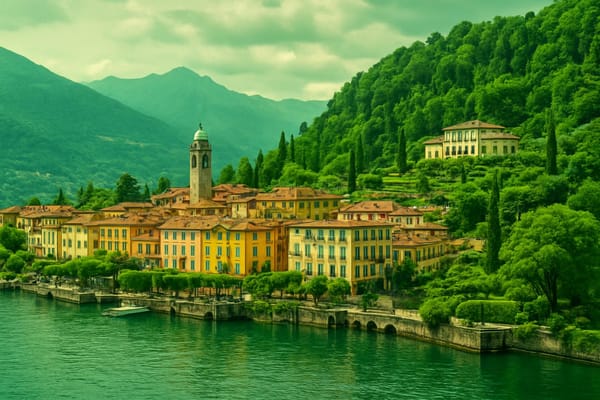Santiago de Compostela
Pilgrimage cathedral, UNESCO World Heritage old town, medieval streets & famed seafood

Important things to know about Santiago de Compostela
Santiago de Compostela is the vibrant capital of Galicia in Spain, a city where daily life blends centuries of history with a lively contemporary rhythm, shaped by its role as an academic hub and regional center; narrow cobblestone streets and solid granite buildings give way to bustling markets, cozy cafés and tapas bars where gastronomy-from fresh seafood influenced by the nearby Atlantic to hearty local produce-anchors social life and seasonal festivals enliven the calendar. As a compact, walkable city, Santiago de Compostela supports a dynamic mix of students, researchers and artisans, and its university presence infuses cultural programming, bookstores and cafés with an intellectual, youthful energy that complements traditional crafts and family-run businesses. The city's identity is strongly Galician: bilingual signage, Galician language and music, and community traditions shape public life while contemporary galleries, music venues and culinary innovation point to a creative future. Weathered facades and green squares reflect an Atlantic-influenced climate that keeps the surrounding landscape lush, and an emphasis on local produce, small-scale producers and sustainable mobility contributes to a quality of life prized by residents. Urban planning favors human-scale streets, public services and a network of neighborhoods that combine quiet residential pockets with lively commercial corridors, making Santiago de Compostela both a place of reflection and everyday activity where history, education, culture and modern living coexist in a distinctive Galician setting.
Sightseeing hot-spots in Santiago de Compostela
Santiago de Compostela is a compact, atmospheric city in Galicia whose very streets tell stories of medieval pilgrims and modern travelers alike. The Old Town is a maze of granite lanes and baroque façades that feels both intimate and monumental, earning UNESCO recognition and drawing visitors eager for authentic sightseeing and cultural discovery. Walking these cobbled alleys, you can feel the lingering presence of the Camino de Santiago - the centuries-old pilgrimage route that ends at the city and continues to shape local life, shops, and hospitality. Photogenic squares and hidden courtyards offer endless opportunities for exploration and photography, making the city a magnet for tourism focused on history and spiritual journeying.
At the heart of the city sits the majestic Cathedral, a masterpiece of Romanesque and later additions that houses the reputed relics of St. James. Inside, the intricate sculptures of the Pórtico de la Gloria draw art lovers, while the dramatic Botafumeiro, a giant thurible swung during special masses, remains one of the most evocative sights for visitors. Pilgrim masses, organ recitals, and the daily rituals around the cathedral create a living heritage experience - combining devotion, architecture, and music in a way few European cities can match. The cathedral precincts and the nearby Obradoiro Square are indispensable stops for anyone interested in the spiritual and architectural highlights of Santiago de Compostela.
Beyond the cathedral, the city rewards leisurely sightseeing with treasures like the imposing Monastery of San Martín Pinario, the tranquil Alameda park with sweeping views over the city, and museums that contextualize the pilgrimage route and Galician art. Culinary delights rooted in Galician cuisine - fresh seafood, empanadas, and local wines - enrich any cultural itinerary, while festivals such as the Feast of St. James animate streets with music and tradition. Whether arriving as a pilgrim or a tourist, Santiago de Compostela offers concentrated cultural depth, making it an essential destination for historic and spiritual travelers alike.
Hotels to enjoy in Santiago de Compostela
Santiago de Compostela hotels offer a unique blend of history, comfort, and Galician charm, making them a top choice for travelers seeking memorable accommodation in northwest Spain. Nestled around the stunning cathedral and the atmospheric Old Town, hotels in Santiago de Compostela range from intimate boutique properties in restored stone buildings to modern luxury hotels with panoramic views and full-service amenities. Pilgrims finishing the Camino find welcoming, practical options with luggage services and early check-ins, while food lovers appreciate hotels located close to vibrant tapas bars and Michelin-starred restaurants showcasing local seafood and traditional Galician dishes. Whether you’re searching for romantic rooms with historic details or budget-friendly, clean lodging for a quick stay, Santiago de Compostela hotels cater to diverse needs with warmth and accessibility.
Choosing the right Santiago de Compostela hotel depends on priorities such as proximity to the cathedral, public transport, or quiet streets for restful nights, and many properties advertise easy access to the city center and cultural landmarks. For the best experience, look for hotels that highlight their central location, free Wi-Fi, and guest reviews emphasizing cleanliness and friendly service - all important signals for travelers and search engines alike. During high season and religious festivals, availability can be limited, so book early to secure your preferred dates and room type. With a growing selection of eco-conscious and family-friendly options, Santiago de Compostela hotels continue to evolve, offering travelers a chance to enjoy the city’s rich heritage, gastronomy, and warm hospitality while staying in accommodations that meet modern expectations.
Restaurants to try in Santiago de Compostela
Santiago de Compostela restaurants offer a rich tapestry of flavors rooted in Galician cuisine and maritime tradition. Strolling through the historic center toward the Catedral, visitors encounter a variety of dining options from cozy taverns to elegant dining rooms, each celebrating fresh seafood and regional products. The signature pulpo a la gallega sits alongside bowls of shellfish and grilled fish, while hearty stews and empanada recall the rural palate of Galicia. Many establishments cater to pilgrims and travelers from the Camino de Santiago, blending fast, satisfying tapas and raciones with slow, chef-driven tasting menus. Whether you prefer a rustic hidden bodega or a contemporary eatery, the city's restaurants balance tradition and innovation, making Santiago de Compostela restaurants a compelling destination for food lovers.
Beyond the cathedral shadow, the Mercado de Abastos plays a central role in the restaurant scene as a source of pristine ingredients for local chefs and a lively spot to sample small plates. Modern kitchens in Santiago combine artisanal cheeses, Galician beef, and seasonal produce with contemporary techniques, and many wine lists proudly feature Albariño and other Atlantic varieties to pair with seafood. The diversity of dining styles-from family-run casa rurales to Michelin-recognized tables-ensures that visitors searching for Santiago dining experiences, authentic Galician flavors, or memorable wine pairings will find options to suit every budget and palate. For travelers and gourmets alike, the culinary landscape of Santiago de Compostela remains an essential part of the cultural and sensory experience.
Best shopping stops in Santiago de Compostela
Santiago de Compostela shopping unfolds like a discovery through its Old Town cobbled streets, where every corner offers a tempting window into Galician culture. The area around the Cathedral is packed with charming boutique shops selling pilgrim souvenirs, artisanal ceramics, and handcrafted jewelry that echo the city’s medieval heritage. Food lovers gravitate to the Mercado de Abastos, a vibrant market where locals buy the freshest seafood, Galician cheeses, and seasonal produce; tasting towers of octopus and local wines make it an essential stop for anyone interested in authentic Galician products. Small family-run stores and specialty shops feature handmade textiles, traditional shawls, and modern designs by emerging Galician designers, making Santiago de Compostela shopping a blend of tradition and contemporary style that appeals to pilgrims, tourists, and style-conscious shoppers alike.
Beyond the market, narrow lanes reveal independent galleries and concept stores showcasing artisan crafts, contemporary ceramics, and thoughtful souvenirs that reflect Galicia’s seafaring and rural roots. Culinary boutiques and delicatessens offer packs of artisanal preserves, honey, and Galician wines ideal for gifts, while cozy shops sell sustainable, locally produced fashion and accessories that emphasize quality and story. Shopping in Santiago de Compostela is also an experience of pauses: stopping for tapas, discovering antiques, and chatting with artisans who explain their craft. For those planning a visit, the city’s retail mix-rooted in heritage yet open to innovation-makes it a compelling destination for anyone seeking authentic and memorable purchases in northern Spain.
Nightlife highlights in Santiago de Compostela
Santiago de Compostela nightlife comes alive as the sun sets over the Old Town, where narrow stone streets lead to lively plazas filled with locals and pilgrims alike. The atmosphere blends historic charm with a youthful energy thanks to the university crowd; you’ll find intimate tapas bars serving Galician specialties like pulpo and hearty raciones alongside creative cocktails and quality Galician wine such as Albariño. Strolling from the Praza do Obradoiro toward the winding alleys, visitors encounter cozy taverns, modern cocktail bars and late-night cafés that stay open well into the early hours, offering a perfect mix of tradition and trend for anyone searching for authentic Santiago de Compostela nightlife experiences.
For music lovers, the city's live scene is a highlight: traditional Galician folk sessions sit comfortably beside indie rock venues and DJ-driven clubs, so there’s always something to suit different tastes. Many spots offer outdoor terraces for relaxed sipping in warm evenings, and cultural events or student nights ensure a dynamic calendar year-round. Whether you’re after a quiet pint in a centuries-old cellar or a lively night dancing to contemporary beats, Santiago de Compostela nightlife delivers memorable evenings framed by historic architecture and friendly hospitality, making it a top destination for nighttime exploration in Galicia.
Getting around in Santiago de Compostela
Santiago de Compostela offers convenient air and rail access that makes the city easy to reach for pilgrims and tourists alike: the Santiago de Compostela airport (SCQ), officially named Rosalía de Castro, sits in Lavacolla just under 10 km from the city center and provides regular domestic flights to Madrid and Barcelona as well as seasonal and European connections, with bus and taxi links and car hire options to reach the historic center quickly; meanwhile the central railway station is served by RENFE Alvia and regional services, delivering reliable connections across Galicia and onward to major Spanish hubs, which is ideal for travelers preferring scenic train routes or combining a Camino arrival with rail onward travel, and the blend of airport convenience and a well-connected train network ensures Santiago de Compostela remains a highly accessible destination for both international visitors and local commuters seeking efficient transport options to nearby cities like A Coruña, Vigo and Ourense.
Culture must-see's in Santiago de Compostela
Santiago de Compostela is a cultural jewel in the heart of Galicia, celebrated worldwide for its Cathedral that anchors the historic center and draws pilgrims along the Camino de Santiago. The city's atmosphere blends medieval stonework with lively modern life: wandering through the Old Town reveals narrow alleys, hidden plazas and centuries-old façades that speak to its status as a UNESCO World Heritage site. Music, folklore and artisan traditions are woven into daily life, from impromptu performances of Galician bagpipes (gaita) in the squares to the seasonal festivals that fill the streets with color and sound. Culinary culture is equally important-tapas-style meals emphasizing fresh Galician cuisine, local seafood and regional wines create a sensory complement to the religious and architectural heritage.
Beyond the Cathedral itself, cultural highlights include the ritual of witnessing the swinging Botafumeiro, venerable monastic institutions, and museums that preserve the artistic and religious history of the region. Contemporary culture thrives in galleries, theaters and a university that injects youthful energy into the old stones, making Santiago a crossroads of tradition and innovation. Visitors come to experience the spiritual legacy of the pilgrimage, to explore museums and markets, and to enjoy the vibrant calendar of concerts and cultural events. For anyone searching for the cultural highlights of Santiago de Compostela, the city offers a compact yet rich tapestry of history, gastronomy, music and ritual that rewards both short stays and extended exploration.
History of Santiago de Compostela
Santiago de Compostela’s history is rooted in the early medieval discovery of what was believed to be the tomb of Saint James the Apostle, a revelation that transformed a quiet Galician hill into one of medieval Europe’s most magnetic spiritual destinations. According to tradition, the remains were found during the 9th century, prompting the construction of a sanctuary and drawing pilgrims from across the continent along routes that would become known collectively as the Camino de Santiago or Way of St. James. Over centuries, Santiago evolved from a site of sacred relic veneration into a bustling religious and cultural hub: monasteries, hospitals for pilgrims, and markets sprang up to serve the constant flow of travelers. The original Romanesque plan of the Cathedral set the stage for later Gothic and Baroque additions, while the growing prestige of Santiago shaped the political and spiritual map of Galicia and Spain, attracting monarchs, clerics, and scholars who sought to be part of the city’s unfolding story.
The High Middle Ages saw Santiago de Compostela flourish as one of Christianity’s major pilgrimage destinations, producing a unique blend of devotion, commerce, and artistic patronage that left an indelible mark on the city’s architecture and institutions. Pilgrims traveled for penitence, protection, or prestige, and their routes fostered cultural exchange and economic vitality; the pilgrim’s shell became an enduring symbol of the Camino. Later periods brought renovations and embellishments-most famously the Baroque façade of the Cathedral on the Praza do Obradoiro and the dramatic Botafumeiro tradition-while the founding of the University of Santiago reinforced the city’s intellectual life. Recognized today as a UNESCO World Heritage site, Santiago de Compostela continues to balance its deep religious roots with contemporary cultural tourism, hosting festivals, academic research, and renewed pilgrimage waves that sustain its centuries-old reputation. Whether viewed through the lens of medieval piety, architectural achievement, or living cultural landscape, Santiago remains a vivid testament to the enduring power of the pilgrimage and the historical resonance of Galicia within Spain.



